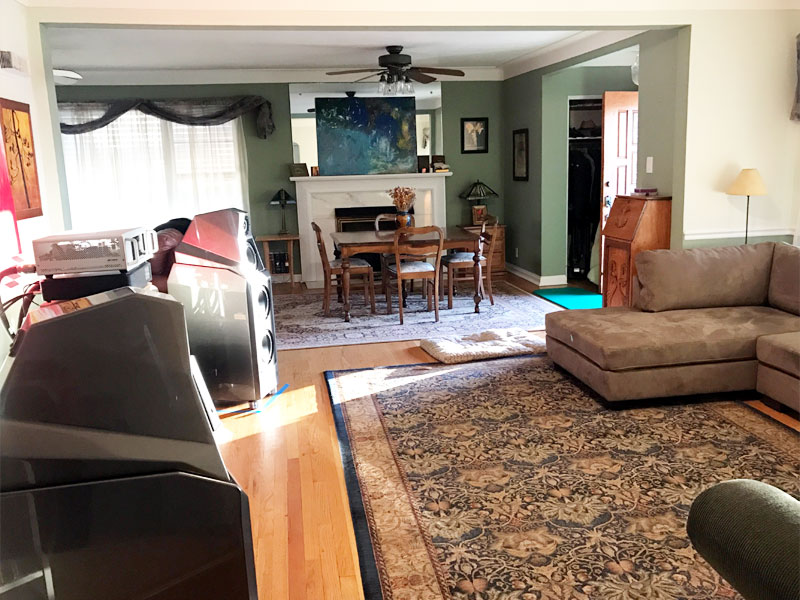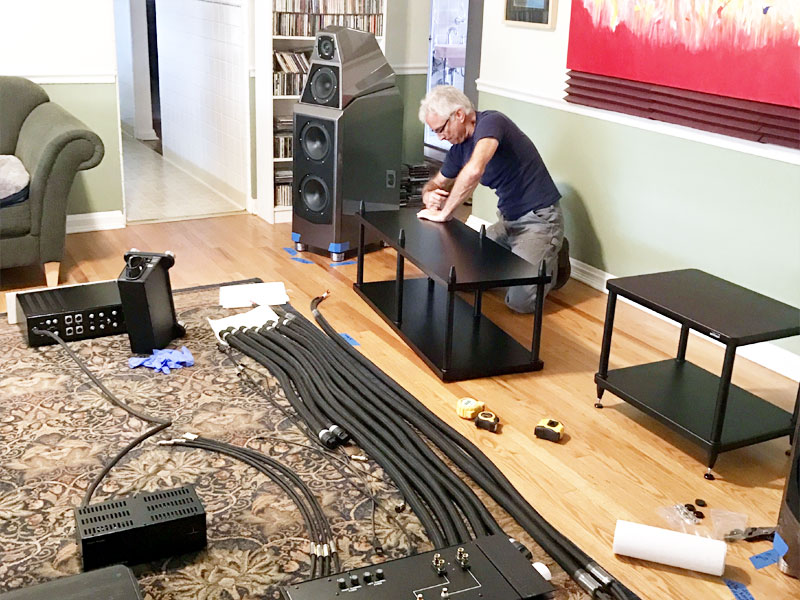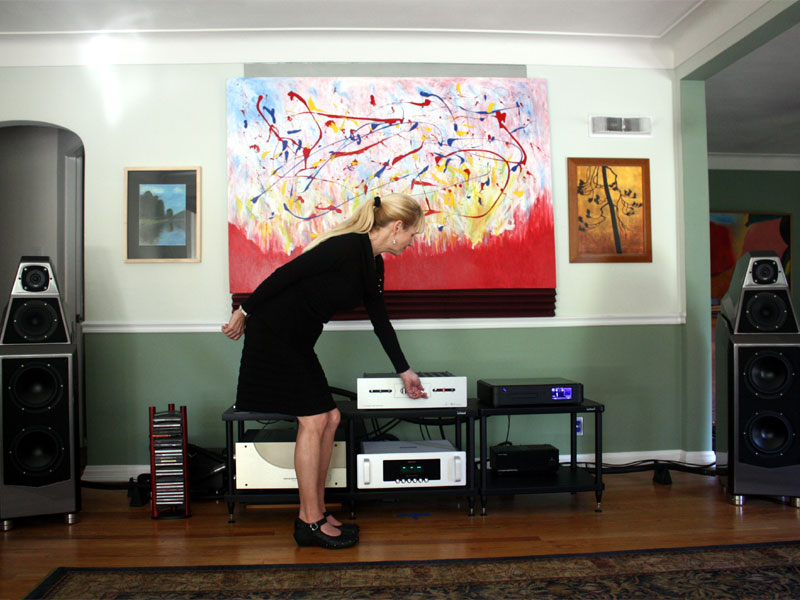Facing What You Don't Know: Audio Systems Optimized
t ain't what you don't know that'll hurt you; it's what you know for sure that ain't so. This quotation has been passed around the Internet for years now, and no one knows exactly who said it first. I've used it in my classroom to warn students about the dangers of judging something prior to investigation, and the words seem particularly appropriate as I propose the following idea: your audio system needs a therapist. That's sort of like saying your dog needs a shrink, I know, but on a few balmy spring days this year, an expert brought the sound in my living room much closer to resembling real, live music than I thought was possible. The expert in question was Stirling Trayle, and his company is Audio Systems Optimized (ASO). TAB readers will recognize him from Roy Gregory's blog and review, but to the uninitiated, I should stress that Trayle never refers to himself as a therapist. It's a weighted term and wouldn't fit neatly into a marketing plan for his services. My wife prefers to call him a system whisperer, but, again, that monicker would alienate the more analytical among us and detract from the intensely organized strategies and highly scientific methods he employs when he does his very serious work. I'm still tempted by these subjective labels because they express my admiration for a person and a system that managed to accomplish what I've been unable to do after more than 25 years of chasing audio nirvana on my own.
While Trayle is fairly well known in the industry for setting up equipment for companies like Wilson Audio, VTL, Rockport, Sonus faber, and Spiral Grove, the challenge for this project was to see whether he could drop into an ordinary living room with all of its family-imposed aesthetic and acoustic limitations and seriously improve a system's sound without interrupting domestic bliss. My listening room occupies a rather unique floor plan and is shared by a host of people who would definitely object to enormous tube traps and a chair placed squarely in front of the speakers. I do not live in a man cave -- not that there's anything wrong with that. The fact is, just about every audiophile who has ever been in my listening space has suggested all manner of room treatment, equipment purchases and furniture rearrangement to address everything from slap echo to room modes. Not surprisingly, technical jargon has never persuaded my ever-patient wife to let this hobby completely take over our home. So I was naturally concerned that Trayle would suggest remedies that could never become a reality. Turns out, he conducts an extensive pre-screening interview and only agrees to take on a system if he thinks he can exceed a customer's needs without compromising their boundaries or budget. He does not sell or endorse equipment, but he will encourage clients to proceed with a planned purchase prior to a visit if he thinks the purchase will help him improve that system's sound. In my case, we agreed that my tall, somewhat shaky 18-year-old equipment rack needed to go. My budget was very limited, so I selected three options and he favored two of them. My final choice of two Solid Steel racks was motivated by my wife's better aesthetic sensibilities and our meager budget. Aside from the rack upgrade and recommending that I have a licensed electrician inspect my breaker box and tighten all ground connections (which eliminated a hum problem I was having), Trayle worked strictly within the limits of my existing room, furnishings and equipment. The first thing he did after arriving was to sit down and listen to my favorite tunes with me for about an hour or so. When I asked, "So, what do you think?" He replied in his jovial, matter-of-fact way, "You've done a great job with setup and it really sounds like music. But it doesn't quite feel like music yet." That was a spooky moment because it was the first time anyone had so perfectly summed up why, after so many years of incremental improvements, I continued to be a bit restless about my system's performance. This may seem like a small thing, but it's worth remembering that an accurate diagnosis is essential if a cure is your ultimate goal. And not unlike the best doctors I've encountered, Trayle began to employ an elaborate combination of more targeted diagnostic questions, measurements, experimentation and highly refined improvisation in his "treatment" of my system's condition.
The first step after the initial evaluation was to completely dismantle my system, inspect everything (inside and out), clean all connections thoroughly with DeoxIT Gold G5 and to correct resonance problems all along the chain from sources to speakers. Trayle is quick to point out that while the quality of any single component's connections or cabinetry might make a negligible difference in sound, their cumulative effect on a system's overall performance is substantial. This explains why, for example, he went to such lengths to ensure that my new equipment racks were perfectly level in spite of the nearly undulating surface of my 70-year-old hardwood floors. I swear you can place a marble on the racks now and it will not roll unless you give it a push. Because the tear-down and rebuild process was both time-consuming and tedious, I suspect more than a few lazy audiophiles like me are unaware of how much better their systems can sound because they simply put off doing the hard work. The result I heard after just this initial phase was much greater clarity, lowered noise floor and a general relaxation of the sound, which made the musical presentation more organic and natural. And while those results were certainly worth a good portion of his fee, it was nothing compared to what came next.
I've seen my share of speakers set up over the years, but Trayle's approach was unique in my experience. He began by turning one speaker completely away from the listening space and focused exclusively on dialing in the remaining one. After several hours (yes, hours), he asked me to sit in my traditional sweet spot and listen to the introduction of Kurt Masur leading the London Philharmonic Orchestra in its live performance of Shostakovich's Symphony No.1 in F Minor, Opus 10 [LPO 0001]. I was dumbfounded when I heard solid images from instruments accurately positioned across a very respectable soundstage. All from one speaker! But the fun didn't end there; he then drew my attention to the moment when the entire orchestra began playing in unison. After a few subtle, but strategically targeted bumps to the speaker's side cabinet and a twist to one of the Stillpoints Ultra 5 supports, I could suddenly hear the lift and swell as the orchestra members all joined in to the performance. There was a palpable movement of air and energy. This, he explained, was what music felt like and what had been missing from my previous setup. It was an exhilarating experience as I began to glimpse the potential outcome of his optimization process. I was already hearing a real physicality to the sound, and he wasn't even finished setting up a single speaker. I'm tempted to say that Stirling Trayle freed my speakers from the constraints of my listening space, but after watching him work for two and half days, I know it's important to explain that he actually made speakers and room become one. And he did this without acoustic treatment of any kind and without requiring any major changes in my system. What impressed me most was how tiny some of the speaker adjustments were; some movements of as little as half a millimeter resulted in changes that either positively and negatively affected the sound. In some cases the differences I heard as the result of Trayle's manipulations were so dramatic that I was tempted to wonder whether I might be lost in a cloud of expectation bias. In fact, before his visit, more than a few skeptical audiophiles warned me not to be impressed by his equipment bag and to definitely bar the door if he brought potions and started burning sage. So, was I merely seduced by some sleight-of-hand? The best I could do to answer that question was to bring over one of those skeptical audiophiles who had made system-improvement suggestions in the past. In other words, this was not one of the smoke-blowers and cheerleaders we all know and love. Steve the Architect has never hesitated to shrug his shoulders when I've been buzzed about a tweak or new piece of equipment if it doesn't float his boat. He dropped by with a friend shortly after Trayle's return to San Francisco and sat sphinx-like as Shostakovich filled the room. From there we moved to a series of Brad Mehldau Trio cuts for what Steve likes to call the "piano test." Soon a faint smile crossed his face as he turned to me and said, "You need to send this guy a Christmas card." Steve confirmed that we were now hearing both the right and left hand of the pianist's performance. This is from a guy who has season tickets to Jazz at the Bistro and has heard his share of live pianos. Steve also noted that my system now had gestalt, which I suppose is a fancy-pants way of saying that the whole performance of the system now exceeds the sum of its parts. It has been a few months since Stirling Trayle's visit, and I'm still getting a steady dose of the goose-bump-inducing moments that make this hobby worth all the scheming, saving, swapping, upgrading, tweaking and obsessing we audiophiles are (in)famous for. It's sound I never thought I'd have without building a dedicated audio sanctuary adjacent to my house.
As if that weren't enough, my wife, who listens to the
system almost as much as I do, is the one who now turns up the music. |




